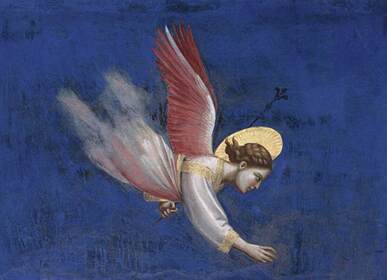Giotto di Bondone, Resurrection 1304-06, fresco, Cappella Scrovegni, Padua
(Resurrectio: Noli me tangere )
And, behold, there was a great earthquake: for the angel of the Lord descended from heaven, and came and rolled back the stone from the door, and sat upon it.
His countenance was like lightning, and his raiment white as snow:
And for fear of him the keepers did shake, and became as dead men.
And the angel answered and said unto the women, Fear not ye: for I know that ye seek Jesus, which was crucified.
He is not here: for he is risen, as he said. Come, see the place where the Lord lay.
And go quickly, and tell his disciples that he is risen from the dead; and, behold, he goeth before you into Galilee; there shall ye see him: lo, I have told you. And they departed quickly from the sepulchre with fear and great joy; and did run to bring his disciples word.
And as they went to tell his disciples, behold, Jesus met them, saying, All hail. And they came and held him by the feet, and worshipped him.
Mathew 28: King James Version
When Christ defies death and rises from his tomb he personifies this great truth and shifts it dimensionally – elevates it to a higher octave – he is born again - yet not as before – he is become luminous – a light body – here and not here, like Giotto's Angels depicted coming momentarily into form - into view - yet incorporeal in their essence.
There are such beautiful stories about Alzheimer sufferers becoming completely lucid in the last moments before death – their sufferings connected only to their bodies it seems– never to their souls.
Times were they were more directly referred to as initiations – a language closer to the ancient world and to myth.
When the hero or heroine return from the underworld – they return from periods of deep initiation – and they come back utterly changed.
The point of the adventure, the trail, the test – the falling away of the known world – and all the rest is precisely this.
Oftentimes it feels like part of us is dying – and in many ways this is true. For the hard truth is - we must die in order to be renewed. This is the essence of transformation – of shifting energetically to a new consciousness.
It is said that after his crucifixion Jesus descended into the underworld and that there was a great harrowing of Hell - whilst on earth darkness descended.
And so it must have been especially for Mary his Mother and Mary Magdalene and all those who loved Jesus.
And so it had been for Demeter, whose daughter was lost beneath the world – and countless other grieving goddesses whose pitiful cries of lament for their lost loved ones came to populate mythology from the third millennium BC. They are known as the Sorrowing Mothers of the world.
In dying & being re-born Christ and his beloveds – his enemies too - partake of this ancient mystery – rooted as we have seen in nature herself – in the psyche and in the sacred cycle of life.
I slept, sings Solomon’s bride,
but my heart is awakened.
Listen; it is the voice of my lover calling:
The winter is past & the rain is over & gone;
Flowers appear on the earth; the time of the singing of birds is come,
And the voice of the turtle dove is heard in our land.
Song of Solomon 2:10-12
"I am the way," he tells us – not just to adore and to worship - but also to follow and to ultimately become!
The words are open to interpretation of course and can be read on several levels, from the literal to the metaphysical - and all are true - like any truly great story, light streams from it in every direction.
The sacred art of the Byzantine period which preceded Giotto had a solemn and holy beauty of its own, but was two-dimensional, immobile, and largely symbolic, writes Madeleine Stebbins.
Giotto initiated a more natural, emotionally expressive human style, which was — it seems — inspired by the spirituality of St. Francis of Assisi, Giotto being a third order Franciscan himself.
Looking at the Lamentation: Madeleine Stebbins
Over the week they have seeped into my soul. Last night I dreamed I was resting within the paintings – in all the blue – the blue of Heaven as we said at the start – and I was still and quiet and peaceful. When I woke I tried to think which painting it was – but couldn’t recall - yet the feeling of deep peace & of the blue remained.
Buona Pasque as they say in Italy,
Happy Easter
much love
Anne Maria
x x x
www.annemariaclarke.net/blog
These meditations for Easter Week are based on the exquisite 14th century fresco cycle by Giotto di Bondone, from The Scrovegni Chapel, Padua (Italy), that so beautifully elucidate the story as it unfolds.








